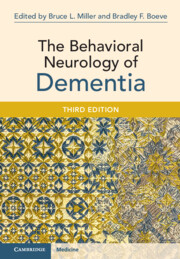Book contents
- The Behavioral Neurology of Dementia
- The Behavioral Neurology of Dementia
- Copyright page
- Contents
- Contributors
- Acknowledgments
- Cover Art
- Abbreviations
- Section 1 Introductory Chapters on Dementia
- Section 2 The Dementias
- Chapter 10 Alzheimer’s Disease: Preclinical to Advanced Dementia
- Chapter 11 The Behavioral Variant of Frontotemporal Dementia: Preclinical to Advanced Dementia
- Chapter 12 Primary Progressive Aphasia
- Chapter 13 The Cognitive Neurology of Corticobasal Degeneration and Progressive Supranuclear Palsy
- Chapter 14 Mild Cognitive Impairment across the Dementias
- Chapter 15 Cognitive Disorders of the Very Old: From Clinic to Pathology
- Chapter 16 Posterior Cortical Atrophy
- Chapter 17 Cognitive and Behavioral Abnormalities of Vascular Cognitive Impairment
- Chapter 18 Creutzfeldt–Jakob Disease and Other Prion Diseases
- Chapter 19 Chronic Traumatic Encephalopathy and Traumatic Brain Injury
- Chapter 20 Normal Pressure Hydrocephalus
- Section 3 Treatment of the Dementias
- Index
- References
Chapter 11 - The Behavioral Variant of Frontotemporal Dementia: Preclinical to Advanced Dementia
from Section 2 - The Dementias
Published online by Cambridge University Press: 17 November 2025
- The Behavioral Neurology of Dementia
- The Behavioral Neurology of Dementia
- Copyright page
- Contents
- Contributors
- Acknowledgments
- Cover Art
- Abbreviations
- Section 1 Introductory Chapters on Dementia
- Section 2 The Dementias
- Chapter 10 Alzheimer’s Disease: Preclinical to Advanced Dementia
- Chapter 11 The Behavioral Variant of Frontotemporal Dementia: Preclinical to Advanced Dementia
- Chapter 12 Primary Progressive Aphasia
- Chapter 13 The Cognitive Neurology of Corticobasal Degeneration and Progressive Supranuclear Palsy
- Chapter 14 Mild Cognitive Impairment across the Dementias
- Chapter 15 Cognitive Disorders of the Very Old: From Clinic to Pathology
- Chapter 16 Posterior Cortical Atrophy
- Chapter 17 Cognitive and Behavioral Abnormalities of Vascular Cognitive Impairment
- Chapter 18 Creutzfeldt–Jakob Disease and Other Prion Diseases
- Chapter 19 Chronic Traumatic Encephalopathy and Traumatic Brain Injury
- Chapter 20 Normal Pressure Hydrocephalus
- Section 3 Treatment of the Dementias
- Index
- References
Summary
The behavioral variant of frontotemporal dementia (bvFTD) is a clinical syndrome characterized by progressive deterioration of social behavior and cognitive functions. It is one of the most common causes of early-onset dementia and is associated with frontotemporal lobar degeneration (FTLD). The diagnosis of bvFTD can be challenging due to its overlap with other psychiatric disorders, but obtaining a detailed clinical history from a reliable informant is essential. Diagnostic criteria for bvFTD include behavioral and cognitive features such as loss of motivation, social disinhibition, lack of empathy, repetitive behaviors, changes in eating habits, and executive dysfunction. Biomarkers such as brain imaging and genetic testing can help increase diagnostic certainty. Disease progression in bvFTD leads to disability and functional deterioration. Future research aims to improve early recognition, diagnostic accuracy, and the development of disease-modifying treatments.
Keywords
Information
- Type
- Chapter
- Information
- The Behavioral Neurology of Dementia , pp. 165 - 179Publisher: Cambridge University PressPrint publication year: 2025
References
Accessibility standard: WCAG 2.1 AA
Why this information is here
This section outlines the accessibility features of this content - including support for screen readers, full keyboard navigation and high-contrast display options. This may not be relevant for you.Accessibility Information
Content Navigation
Allows you to navigate directly to chapters, sections, or non‐text items through a linked table of contents, reducing the need for extensive scrolling.
Provides an interactive index, letting you go straight to where a term or subject appears in the text without manual searching.
Reading Order & Textual Equivalents
You will encounter all content (including footnotes, captions, etc.) in a clear, sequential flow, making it easier to follow with assistive tools like screen readers.
You get concise descriptions (for images, charts, or media clips), ensuring you do not miss crucial information when visual or audio elements are not accessible.
Visual Accessibility
You will still understand key ideas or prompts without relying solely on colour, which is especially helpful if you have colour vision deficiencies.
Structural and Technical Features
You gain clarity from ARIA (Accessible Rich Internet Applications) roles and attributes, as they help assistive technologies interpret how each part of the content functions.
